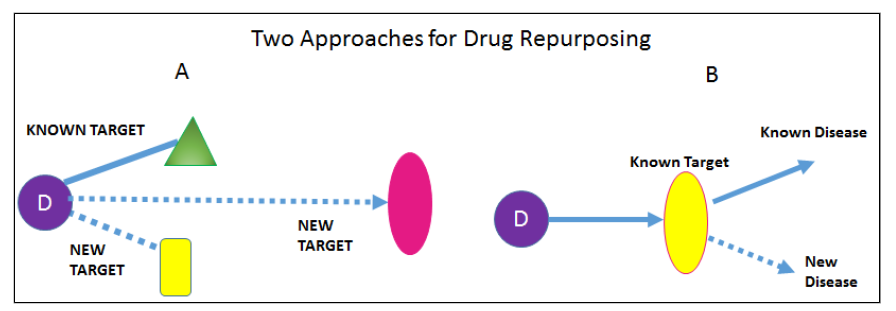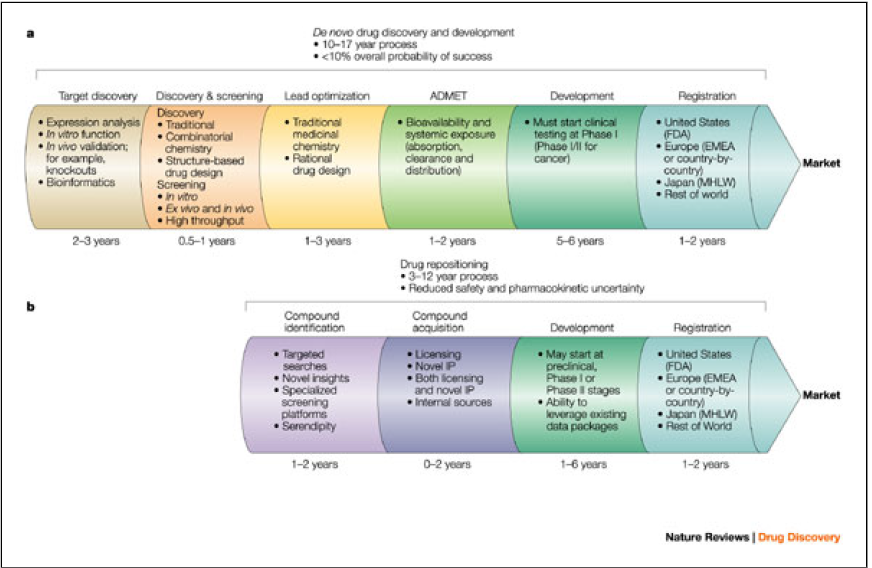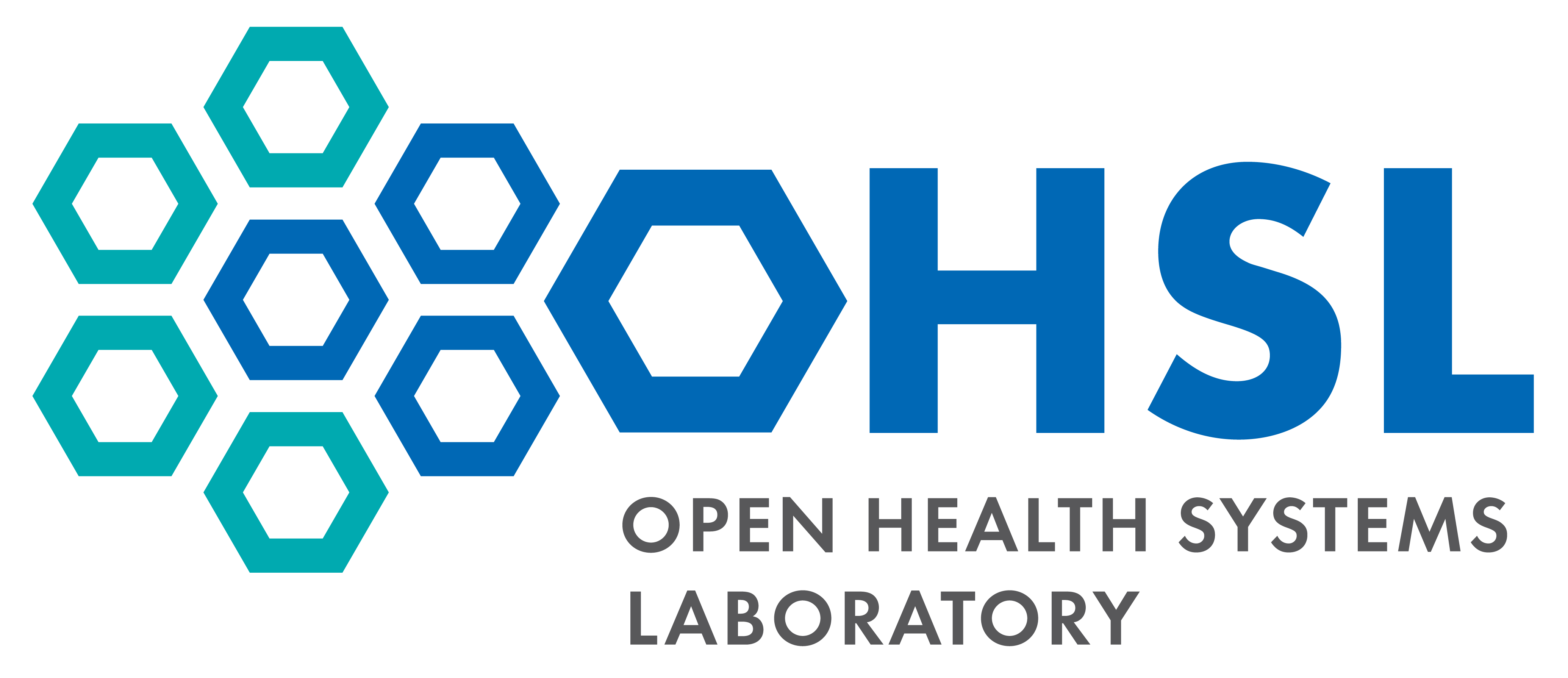The process of using existing approved drugs in new disease areas is called drug repurposing or repositioning. Rescuing or reusing the previously studied small molecules and biologics that were shelved or using old drugs or compounds for new indications is an attractive alternative to the traditional form of drug discovery. As oppose to a traditional drug discovery that takes about 10-15 years and costs between 500 million and 2 billions dollars, drug reposition costs between 8 to 9 million dollars and upto 10 years. Clearly the idea of re-tasking the drugs being both cost effective and advantageous with respect to time, has stimulated the pharmaceutical market to work in this direction resulting in launching about 20-30% repositioned drugs over the last decade.

Fig.1 Two approaches for drug repurposing.(A) The first approach is a single drug (D) may react with multiple target therefore could be used for known and new targets. (B) The second approach is using drug for a known target that is involved in multiple diseases or biological processes. Adapted and modified from" Innovative Strategies for Drug Repurposing" Published on Drug Discovery & Development (http://www.dddmag.com) by Daniel Grau, M.Phil, and George Serbedzija, PhD (permission pending)
Advantages of drug repositioning:
- Most of the repositioned drugs are the compounds that have been approved and their safety, toxicology and bio-availability profiles investigated. They also have an established course with respect to formulation and manufacturing.
- They can therefore enter clinical trials much faster giving it approximately 30% developmental advantage as compared to a non-repositioned drug.
- Relaunching a repositioned drug versus a new drug, saves millions of dollars for a company.
- Early market availability of a drug can result in saving lives of patients with other wise very few to no therapeutic options.
- Companies can make huge profits with a successful repositioned drugs and maybe encouraged to out-license some of their clinical drugs that were shelved or discontinued for any reasons.
Rapidly developing cutting edge, high throughput technologies that enable studying drug interactions at genomic level could helps us view the challenges of drug repositioning in a new light.

Fig.2 Advantages of repurposing drugs over the traditional discovery method. a. The time required for various steps involved in drug discovery, from target discovery until the drug reaches the market, have been shown along with average time required for each process. b. The time required for a repurposed drug to reach the market has been shown. The initial time required for target discovery and screening can be saved has been indicated by the comparing the two bars. The figure has been adapted from "Drug repositioning: identifying and developing new uses for existing drugs" , Nature Reviews Drug Discovery 3, 673-683 (August 2004) by Ted T. Ashburn & Karl B. Thor with permission.
Individual success story for a repositioned drug launched:
- Revitalization of thalidomide by Celgene Corp., Summit, N.J.
- Thalidomide, prescribed in the 1950s for nausea and insomnia in pregnant women, was found to cause severe birth defects in
- children when the drug was taken in the first trimester of pregnancy. Scientists later discovered that in addition to its sedative effect,
- thalidomide had anti-angiogenic and immuno-modulatory effects, including the inhibition of TNF alpha. In 1998, Celgene received
- approval from the US Food and Drug Administration (FDA) to market Thalomid (thalidomide) as a treatment for leprosy. Since its
- release, Thalomid has become the flagship product for Celgene.
- New drugs approved by the United States FDA for oncology indications, 2000 to 2009 .
References:
- https://en.wikipedia.org/wiki/Drug_repositioning
- "Drug Repurposing" Chemical and Engineering News,Oct 1,2012,Vol 90(40)15-25
- Nature Reviews Drug Discovery 3, 673-683 (August 2004) | doi:10.1038/nrd1468
- www.ddw-online.com › Business
- http://www.dddmag.com/articles/2007/09/innovative-strategies-drug-repurposing
- Natalia Novac, Challenges and opportunities of drug repositioning, Trends in Pharmacological Sciences, Volume 34, Issue 5, May
- 2013, Pages 267-272, ISSN 0165-6147, http://dx.doi.org/10.1016/j.tips.2013.03.004.
Role of OHSL in RRDC project
The consortium is actively involved in execution/planning and development of the projects and involving individual scientists and teams that are active in repositioning of old drugs to yield a better cost effective treatment therapy. OHSL provides a common global platform for various related individuals to come together, interact and work on various related issues using modern technology thereby by overcoming geographical limitations. OHSL plans to build a frame work around few areas by collaborative effort that leads to re tasking of these molecules. These are collaborative approaches would bring researchers from different walk of life such as computational, structural, Data mining scientists, preclinical and clinical researchers, to work together on drug repositioning for cancer. In future OHSL hopes to expand its network and provide services which could enable researchers an easy access to not limited to data banks but also, on site aid with respect to laboratory resources, collaborations and grants.
Challenges of drug repositioning:
- Obtaining an upfront investment for repositioning a drug with a prior failure record is a difficult task.
- If a company has it R&D specialized in certain area repositioning projects may not be in its scope. Although out-licensing the drug for conducting investigator-sponsored clinical trials, may seem like a sensible solution, finding a contract research organization(CRO) or a biotech company who would invest in such a risky venture may be onerous.
- For a repositioning candidate new criteria for patient inclusions in clinical trial, novel study end points and efficacy measures have to be developed. All this comes at an added expense to the company.
- Compounds are protected by patent for only 20 years and repositioning a drug after it has lost approximately 6 years in first phase in R&D of can prove very challenging with respect to time.
- Although patents could be extended by changing dosage or route of administration or generating a secondary "method of use" (MOU) patent, most patents protect compounds for a broad range of indicators making this process almost impossible.
- Toxicological or pharmacokinetic data that was collected for the repostioning compound in original indication may not be acceptable for new indication due to changes in regulatory standards.
- Pharmaceutical company may not find it profitable to reposition a low costing drug used for common diseases such as high blood pressure being used for "orphan disease" or cancer where drug cost is very high despite being medically useful and profitable for patients.
Current Collaborations:
- NCI/NIH
- DUKE—Lyerly Lab,
- Section if Applied
- Therapeutics
- IIT DELHI
- CDAC PUNE
- TMC MUMBAI
- ACTREC MUMBAI

Add new comment